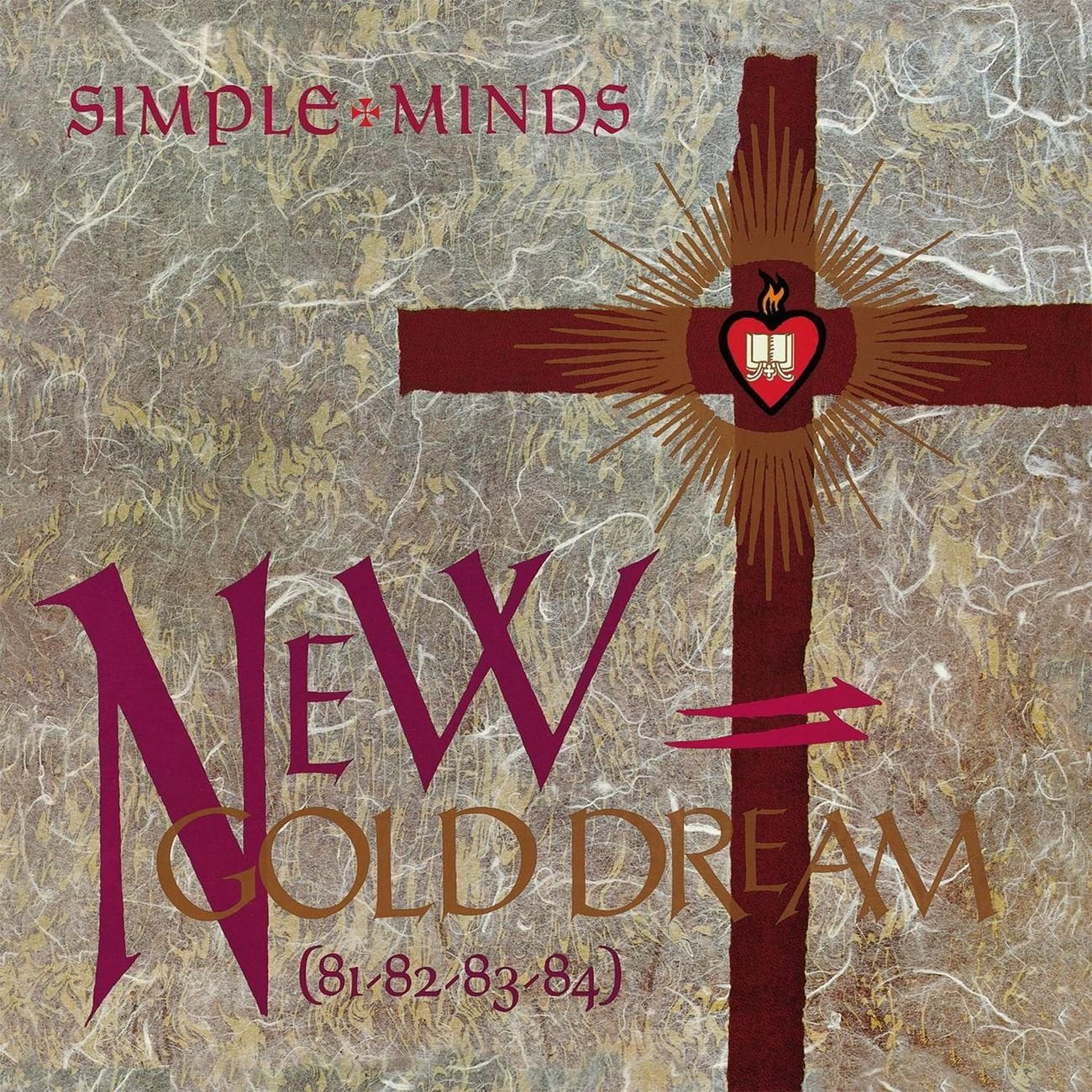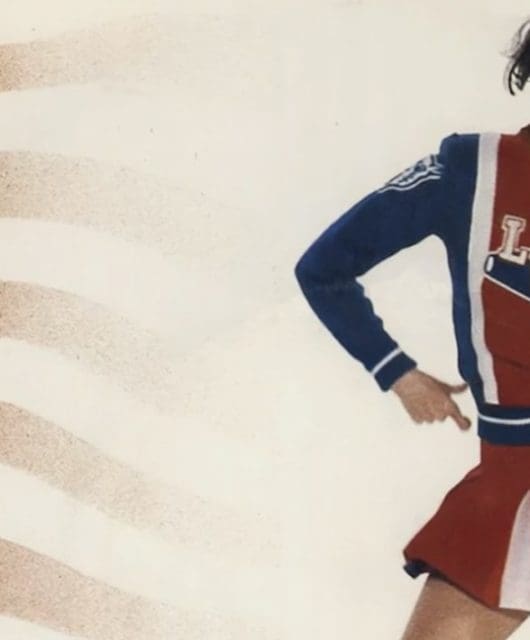Making Simple Minds: New Gold Dream (81-82-83-84)
By Andy Jones | April 8, 2022

Critical acclaim is one thing, but what Simple Minds really desired in 1982 was a hit record. With their fifth studio album, New Gold Dream (81-82-83-84), they finally got it, but it took a total reinvention of their sound to achieve the goal. By Andy Jones
New Gold Dream (81-82-83-84) was a seismic album for everyone involved in its recording. With Simple Minds, it marked the start of their success, proper; the band had certainly enjoyed the critics’ praise previous to its recording, with four more experimental albums that they had released in the previous three years.
But critical acclaim doesn’t put food on the table – in fact their lack of success had put the band in debt – so they were certainly ready for, and gearing up to, hit records.
They had already attempted chart single success but with little impact, including the superb trio of 45s The American, I Travel and Love Song which had all failed to get anywhere near the Top 40. New Gold Dream would be the album that didn’t just unlock the doors to the charts, it smashed them down, paving the way for many more hit records.
At the start of 1982, the band were buoyed by success in Australia – Love Song was a Top 10 hit and the band had played a successful tour there in late 1981 – so they began writing tracks for their fifth album, New Gold Dream, at Rockfield Studios, with some confidence. “The penny dropped,” Jim Kerr told Louder, “and we started thinking: maybe we can be pop stars as well.”
And then there was Peter Walsh, the almost-accidental producer who oversaw the recording of New Gold Dream. He was an engineer in Utopia Studios in the 70s, working with Stevie Wonder, The Boomtown Rats and other big names, but his only actual production experience in 1982 had come by way of a couple of debut albums from Heaven 17 (Penthouse & Pavement, on which he was assistant producer) and China Crisis, (with whom his first full production credit was earned by way of their debut record, Difficult Shapes & Passive Rhythms, featuring their massive hit Christian).
These would be go on to be critically-lauded debut albums, of course, but in 1982 they had yet to gain much traction, so Walsh wasn’t exactly in demand. As luck would have it, he was asked to remix Simple Minds’ Sweat In Bullet track from their fourth album (and first on Virgin Records) Sons And Fascination.
After reworking the track with the band’s guitarist Charlie Burchill, he was asked to produce the band’s (eventual breakthrough hit) Promised You A Miracle, all thanks to an approach that differed to a lot of producers of the time; Walsh preferred to strip productions back rather than build them up, something that had impressed Burchill: “Pete’s taken a ton of stuff out… but don’t worry. It sounds amazing. You’ll love it,” he told Kerr at the time, according to the liner notes in the boxset reissue of New Gold Dream. And this approach eventually landed him the full-time gig to produce the album.
Incredibly for a band who had already notched up four albums, Kerr and Burchill were just 21 as this fifth album started to come together. However, they were also at something of a creative peak and lead single, Promised You A Miracle, was produced in just three days at Townhouse Studios in London, with such a focus on producing a hit record that it was quickly edited for radio.
The track also made use of new guitar effects and amps to help the band focus on a new musical direction; the drums too had ‘a sound’ helped by the distinctive recording space at Townhouse, so Simple Minds and Walsh were quickly assembling a sonic blueprint to aim at for the rest of the album’s recording.
“After Promised You A Miracle,” Walsh recalls on the Simple Minds YouTube channel, “I think King Is White And In The Crowd had also been demoed so we had an early reference point with those songs. In fact when we recorded them we were like, ‘let’s not mess this up because it already sounds great’.”
The new direction was given credence when Promised You A Miracle broke into the UK top 40, the first Simple Minds single to do so and, as it climbed the charts, the band decamped to a rehearsal room in Fife called The Old Mill to work on the rest of the tracks for the album, building instrumental arrangements while Kerr worked on the vocals.
The stay at The Old Mill was also an important sonic chapter for the band as, by chance, it helped them further home in on their new sound.
The sessions were recorded on a cassette ghetto blaster for the band to listen back to and use as a reference point, but they were so enamoured by the overly compressed feel of these recordings that they decided to bring that sound to the recording of the actual album. For this, and after the songs had been moulded in Fife, the band returned to Townhouse in London to work on what would become New Gold Dream (81-82-83-84).
Read more: Simple Minds interview
Read more: Simple Minds Superfan
With their new path firmly mapped out thanks to the Fife recordings and Promised You A Miracle, the album came together relatively quickly, with the band firing on all cylinders, and Walsh getting on well with the band and relishing his new production role, more in this case as someone to help capture and mould the ideas as they flowed in earnest.
“When you go into a studio you want to work with musicians who are bubbling over with ideas,” he explains, “it then just becomes a question of arranging ideas. We got on really well. Jim in particular gave us all so much confidence. I was a young engineer and this was one of my first productions. It was a chemistry that clicked from the word go and actually still exists today.”
As well as a strong bass sound across the album – often bolstered with a Moog synth – New Gold Dream is also defined by a drum sound, partly down to that distinctive recording space at Townhouse, but sometimes through Walsh’s decision to record two drummers playing simultaneously. It was a tumultuous time for drummers in Simple Minds, almost to Spinal Tap levels.
Brian McGee had played on all four of the band’s previous albums but left in late ‘81, to be replaced by Kenny Hyslop who only stayed long enough to play on Promised You A Miracle before resigning. For New Gold Dream, Mike Ogletree was drafted in but Walsh also asked his friend Mel Gaynor to bolster the line-up and sound, particularly on the title track.
“New Gold Dream [the track] needed something special,” Walsh explains, “so I came up with the idea of both of them playing drums at the same time. I set them up facing each other. One of the guys would have the fill going into the first chorus, one the fill into the second chorus. One was doing the cymbals, the other wasn’t. So it was orchestrated in a way and I can remember standing in the middle of them actually conducting.”
The plan worked. New Gold Dream is a heavy beast of cycling synths and almost trance-like textures – so much so that it was revisited by several dance acts in the 90s.
Kerr’s vocals on the song were the last he came up with for the album (and tended to be the last element added across all of the tracks on the album) and were mostly recorded at The Manor Studio where the band relocated to finish the recording of the album.
Read more: Peter Hook interview
Read more: The story of 1981
New Gold Dream came out in September 1982 and after huge critical acclaim, went further chart wise than any of its singles, peaking at No.3 in the UK and eventually spending a year in the album charts, shifting 300,000 copies along the way.
“I think we all thought the album was special, even before we started doing the tracks,” Walsh says looking back at NGD. “The album does have a timeless, endless quality to it and I think it’s been the soundtrack to a lot of people’s lives and experiences. We knew we had something special and something great at the time.”
Kerr is a little more logical and doesn’t perhaps see the recording as such a major shift in direction – more a natural progression. Either way, his analogy with a new dawn is quite beautiful: “To me New Gold Dream sums up the paths that we had gone on on the first four records,” he told Louder.
“Some with dark moods, some intense, some claustrophobic. And the storm broke, and then the next day you have a beautiful morning. New Gold Dream, the title, the artwork, the language of a lot of the songs, resonates that to me.”
Simple Minds: New Gold Dream (81-82-83-84) – the songs
Someone Somewhere in Summertime
It was the third single from the album, but as the opening track Someone… was the perfect vehicle to announce the more melodic and less experimental future for the band, and from the off makes the message clear: this is about catchy melodies, insistent baselines, mesmerising backdrops, Kerr’s majestic lyrics and snippets of influences from a huge variety of sources, all of it forging an instant new sound and future. This is Simple Minds MkII. Here we are. Don’t you forget about us. Well, not until…
Colours Fly and the Catherine Wheel
Having just announced their change in intent, Colours… takes you back to an earlier Minds sound, with full-on meandering bass parts, incidental effects, processed guitars and Kerr’s moody vocals swinging you between Roxy Music, Ultravox! Mk1, and both Simple Minds incarnations. Sure it’s catchy and it’s certainly by no means the worst track on Dream but, well, maybe they had to get something out of their system.
Promised You a Miracle
We know by now that Derek Forbes’ bass is a huge part of New Gold Dream sound and it is even bigger here – a Fender Precision doubled with a Moog synth underpinning the strongest track on the album – but it’s the guitar and synth stabs, and Kerr’s lyrics, that are also the standouts on Promised… By the time they recorded the track, the band were in a large amount of debt and in need of something of a miracle to get them out of it and herald in some much-needed chart success. And in three blessed days at Townhouse Studios they recorded a stunning track that would not only give them that success, but deliver a new direction and the start of a record-breaking run of chart hits. The promise and miracle were certainly delivered.
Big Sleep
It’s a middling track on the album in terms of position but all the elements are here for the future of Simple Minds. With big synth riffs, an evolving arrangement and hands-in-the-air moments, Big Sleep is almost designed as a future stadium favourite, and the perfect vehicle for the new style of Kerr vocal which would ring out in major venues for the next four decades or so.
Somebody Up There Likes You
Quite easily a track that could have been conceived by bass king Mick Karn and synth master Richard Barbieri from fellow art-house pop wannabes Japan. This is all about some glorious synth string and chord progressions, twangy bass lines and very moody effects. The prog-style changes of pace don’t quite work but nor do they detract from an instrumental that gets under your skin in a surprisingly virulent way. And when the track builds and flows, you are straight back in your bedroom playing the vinyl on a battered, old radiogram. Quite stunning.
New Gold Dream
New Gold Dream has some of the best riffs and biggest beats – you can almost see producer Peter Walsh conducting the twin drummers, so strident is the rhythm section – as perhaps it should given it’s the title track. But it’s a memorable piece of Simple Minds some 40 years later for other, perhaps less obvious reasons, as its standout moments were later adopted by the dance community in the early- to mid-90s. Bands including Utah Saints and U.S.U.R.A. produced versions of the track – with the main melodies and lyrics sampled or reinterpreted – and almost soundtracked an entire strain of the then-all-new electronic genre, extending the life of a track, opening the band up to a completely new audience and helping the album of the same name attain an even cooler status.
Glittering Prize
Another Top 20 hit in the UK (and a second Top 10 in both Australia and New Zealand), Glittering Prize solidifies the new Simple Minds sound but also offers the clearest Kerr vocal so far, it having arguably been somewhat buried in the new ideas in previous songs. Here it seems more prominent in the mix, either because the arrangement is sparser (bar the bass, of course) or because much of the rest of the new-found pomp has pulled back in the mix… until the chorus, that is, when we get a lovely blend of new and old. And there’s rarely a more direct and passionate lyric on the album than, “First taking hearts, then our last breath away”.
Hunter and the Hunted
Well, it maintains the same sound and theme as the rest of the album, but Hunter And The Hunted is arguably the most forgettable track on New Gold Dream, almost a pastiche of the new sound before it is even established as being the new sound! It’s nice enough and the atmosphere is all there but one or two more riffs would have been welcome. New Gold Snooze…
King is White and in the Crowd
Opening with similar electronic beats that open the title track, King… doesn’t reach the same heights, and possesses a slower-paced and quite maudlin feel. Never mind, though – the peaks have been scaled, the new plan is firmly in place and the Minds have a sound that will conquer the world. The US beckons, and the sound is primed.
Simple Minds’ official website






